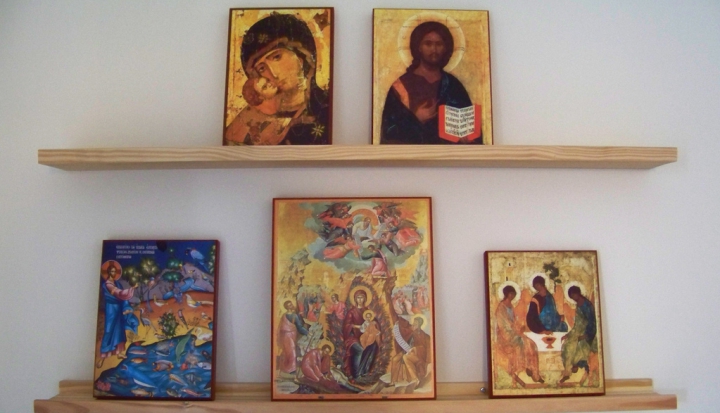Our family was visiting our pastor’s house when our daughter Teenasia, then 9, commented on a framed print on the wall. It was a black Madonna and child. “That is so cool,” she said. “Baby Jesus is wearing an African shirt. I love that.” A couple weeks later after Mass, Father Mike gave Teenasia a smaller version of the print. It hangs outside our kitchen, near our huge dry-erase family calendar. The print is not only a reminder of our family’s faith in Jesus and our trust in his mother, but also a reminder to Teenasia of Father Mike’s thoughtfulness and generosity.
Religious art in our homes is a way we brand ourselves as Catholics and Christians. Children understand branding. They know the brands they see more often are more popular, more valued. Every swoosh on a friend’s soccer cleat is a reminder of what brand to buy on the next shopping trip.
Religious art in the home serves a similar purpose, establishing a key element of what a family stands for. Placing a cross on the wall or a statue of St. Francis in the yard is an intentional way to remind ourselves and our children of our commitment to our faith. Just as the golden arches, the swoosh, and the apple define their respective products as belonging to a specific company, the images that symbolize our faith can define our family and our home as belonging to Christ.
Conversation starters
A piece of art or a cross serves as a point of focus, turning our thoughts toward the holy.
Katie and Kevin, parents of two small boys and a baby on the way, have a portrait of Mary with the child Jesus in 3-year-old Bennett’s bedroom. “Bennett likes to gaze at it as he falls asleep. He asks many profound questions about Jesus, God, and Mary,” says Katie. “He often asks, ‘Does Jesus fall asleep when it is dark, too?’ He asks questions about the things Jesus thinks about as a baby and an adult. I think he really likes to relate to Jesus this way, as a little boy who looks like him, with his mother who loves him. I don’t know if these questions would come up if we didn’t have this piece of art.”
Carol, mother of four, found her daughter Anna, then 7, staring out the window in intense prayer one day. Next to the window was an etching of the Bible verse about being able to move a mountain with faith the size of a mustard seed. “Anna told me she had been praying for the hill outside our window to move, and it didn’t, and this was proof that the verse was wrong,” Carol says. The moment allowed Carol to talk to her daughter about what the verse meant, and about the difference between figurative and literal language in the Bible. “I explained, in a way she could understand, that the message wasn’t about moving an actual mountain, but about how we will be faced with difficulties that feel as big as a mountain in our lives. And that God would be with us during those times, helping us through. Now that she is older, that verse on the wall has a deeper meaning.”
Moving us to prayer
Amy, mother of three teenagers, has a statue of Mary on their staircase landing. “Each one of my children bow briefly to Mary when they pass her. The statue was a gift from friends whom I volunteered and lived in community with as a young adult.” In addition, Amy has a smaller Nambe Mary statue on her kitchen windowsill. “Each morning before my coffee, I fill up a small bowl of water and place my prayers in the bowl. I place that bowl by Mary. At night, I give those prayers to the earth by pouring the water out.”
Dave and Grace, parents of five, have consecrated their home to the Sacred Heart of Jesus. They have a painting of the Sacred Heart in their home, created by an artist friend who survived a broken neck. “On first Fridays, we often light a candle and reflect on a Sacred Heart theme,” Grace says. “In very difficult moments, we gather there and recite a prayer together or take turns praying in our own words. At times of great joy, we offer prayers of thanksgiving and praise there. It is also very powerful simply to stand together in front of the image in silence.”
Jen and Dave, parents of two boys, received a picture of Jesus hugging a lamb as a wedding gift. For both of them—professionals working full-time in competitive fields—the soft image brings comfort. “Dave and I have had three houses together; we have made it a point to hang up this piece in each of our homes. It is such a loving picture and reminds me that Jesus loves us all. It is important to have physical reminders of our faith in our house because we want our boys to know it is part of our daily lives.”
Spirit beyond home
Andrea, a social worker and mother of two young adults, has a drawing hanging in her house of what she describes as the “hippie Jesus” by Francis Hook. “I first encountered this in 1983 on a youth leadership retreat,” she says. “I was so moved when I saw it in the retreat center. I felt this image portrayed Jesus as warm, open, loving, and approachable. The kind of leader I could admire, revere, and yet relate to as a 16-year-old. When I was confirmed, my sister took me shopping to buy a large framed print of this drawing. It has hung in my home ever since—an example of the socially-just Jesus who ‘hung out’ with people and showed them compassion, mercy, unconditional love, and friendship. This piece reminds me of how I want to do my job within the foster care system.”
Nate Ganfield, an attorney and father of four, has a painting of Jesus talking to a man in a suit. Under the painting is a verse from Psalm 1:1: “Blessed is the one who does not walk in step with the wicked or stand in the way that sinners take or sit in the company of mockers.” Nate’s wife Tawnya sees the painting as an important focus for her husband, whose professional life can be challenging. “Sometimes Nate’s clients have asked him to do things that are legal but morally questionable,” she says. “To these clients, Nate will say, ‘Yes, you can do that legally, but is it the right thing to do?’ The picture is a reminder in our home of who he is called to be, at home and at work.”
Religious art can be smaller and more private. When Amy dropped her oldest son at college, he asked her for a key ring as she was getting ready to leave his room. She took her keys off her own key ring, a Christian fish that belonged to her father who had died several years before. “I gave my key ring to him. I said that each time he opened his dorm door, he would remember I was praying for him—and so was ‘Big G,’ the name he called my dad.”
This article appears in the March 2016 issue of U.S. Catholic (Vol. 81, No. 3, pages 43–44).
Image: Flickr cc via Else-Maria Tennessen
















Add comment